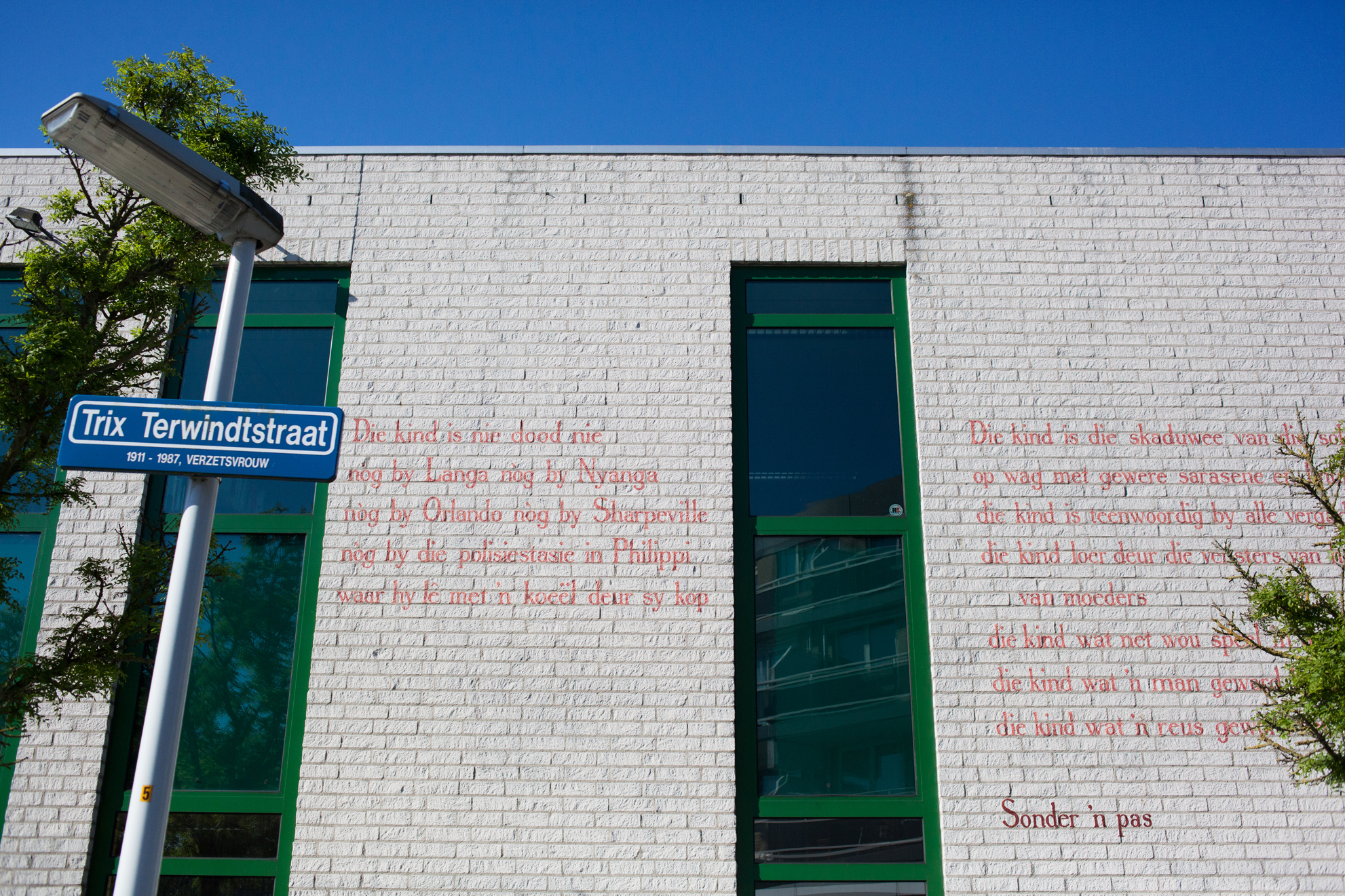Het kind dat doodgeschoten is door soldaten bij Nyanga
Het kind is niet dood
het kind heft zijn vuist naar zijn moeder
die Afrika schreeuwt de geur schreeuwt
van vrijheid en heide
in de townships van het omsingelde hart
het kind heft zijn vuist naar zijn vader
in de optocht van de generaties
die Afrika schreeuwen de geur schreeuwen
van gerechtigheid en bloed
in de straten van zijn gewapende trots
Het kind is niet dood
noch bij Langa noch bij Nyanga
noch bij Orlando noch bij Sharpville
noch bij het politiebureau van Philippi
waar het ligt met een kogel door zijn hoofd
Het kind is de schaduw van de soldaten
op wacht met geweren pantserwagens en knuppels
het kind is aanwezig bij alle vergaderingen en wetgevingen
het kind loert door de vensters van huizen en in de harten
van moeders
het kind dat alleen maar wilde spelen in de zon bij Nyanga is overal
het kind dat een man is geworden trekt door heel Afrika
het kind dat een reus is geworden trekt door de gehele wereld
Zonder pas
Vertaling: Gerrit Komrij
Is Afrikaans your native language and would you like to recite this poem? Please contact us at muurgedichten@taalmuseum.nl!
This poem in 60 seconds
In the South-Africa of the 1960s, the country segregated by apartheid, a child is shot dead. Ingrid Jonker captures her feelings in a poem. Though initially controversial, the poem rises to national acclaim, especially with Nelson Mandela reading it at the first hearing of the democratically elected parliament in 1994. Die Kind is a charge against violence but also leaves hope for generations to come.
Want to know more? On this website you can listen to the poem, discover its origins and its author and find out what the poem means to the people of Leiden.
Ingrid Jonker
Douglas 1933 - Kaapstad 1965
Ingrid Jonker was a free spirit. Friends described her as beautiful, smart, charming, and fierce. She passionately debated matters close to her heart. For the larger part of her life, Jonker lived with her daughter in an art colony in Bay Clifton, near Cape Town. The artists were all anti-apartheid, but at the same time they refrained from any strong political engagement.
Liberal childhood in Cape Town
Ingrid Jonker’s father left before she was born. As her mother was often ill, she was largely raised by her grandmother. They lived in Cape Town, and a lot of their time was spent on the beach. Ingrid wrote many short poems, which her grandmother sang to her. At the age of twelve, Jonkers lost both her mother and her grandmother in quick succession, and was then forced to live with her conservative father, whom she had never met before. Their bond remained a difficult one throughout her life.
Journey to Europe
In 1964, Jonker won the ABP prize. She used the prize money to travel through Europa. As her mental health deteriorated, she had herself admitted at a psychiatric facility in Paris. Upon her return to South-Africa, she was unable to recover, and took her own life by drowning herself in 1965.
What's this poem about?
“The child is not dead” is how the poem starts. The child is, however, at the police station at Philippi with a bullet through his brain, as Jonker tells us in the third stanza. And yet the child lives on, as a symbol of resistance and as a charge against violence and oppression. The same is true for the innocent children shot by the police in the other places she mentions.
Glimpse of the future
The child will pass judgement on previous generations; on protesting fathers and mothers, on soldiers and lawmakers, and on all those who contribute to an environment unsafe for the child to play in. It will transform into a giant, unaffected by borders and pass laws. The ending of the poem is therefore an optimistic one, an appeal, almost.
Origin story
On 21 March 1960, South Africa saw large demonstrations against the pass laws. These laws were a fundamental aspect of apartheid, as these mandatory forms of identification were designed to keep people of color out of white areas. When the regulations were tightened up, non-white South Africans lost much of their freedom of movement, and protests arose.
In Sharpeville, a suburban district of Johannesburg, police opened fire on the protestors. Sixty-nine people were killed, among whom several children. In Nyanga, a township near Cape Town, a child of only one and a half years old was shot dead in his mother’s arms. Being the mother of a three year-old herself, Ingrid Jonker was shocked by the violence. She went down to the police station of Philippi to see the child’s body, and then wrote this poem.
Stories from Leiden
Ella is happy. Her mother gave her a pretty yellow ball, when they went for groceries. Because the weather is so nice. The ball rolls off and bounces across the street. Ella runs after it. There are many cars. Luckily, they are parked. Ella throws the ball against the wall. Painted on the wall is Die Kind (the child), in Afrikaans. Two verses of a poem by Ingrid Jonker. Ingrid’s child is scared. Because mothers scream and fathers fight. Because her mother died and her father left her alone. Ella cannot read yet. She is just happy with her new ball. She throws it up at the sun and laughs.

Photography: Patricia Nauta
Text: Joop van Gerven
Share your story
Does this poem hold a special place in your heart? For example, do you remember when you first read the poem? Or did you come across it someplace unexpected? Let us know! We would love to add your story to our website.
Ingrid Jonker in Leiden

This poem was painted onto one of the library buildings of BplusC in 1998.

Photos Anoesjka Minnaard
Ingrid Jonker and Apartheid
When Ingrid Jonker published this poem, it was immediately the subject of controversy in South Africa. The poem was rejected, even by adversaries of apartheid, due to its sharp tone and because it was deemed ‘unfinished.’ Jonker refused to alter it. General appreciation for the poem has increased considerably since then.
Mandela and Die Kind
In 1994, president Nelson Mandela opened the first hearing of the first democratically elected parliament with the words: “In the dark days, when all seemed hopeless in our country, when many refused to hear her resonate voice, she took her own life. She was both an Afrikaner and an African. Her name is Ingrid Jonker. In the aftermath of the massacre of the anti-pass demonstration in Sharpeville, she wrote the poem Die Kind.” He proceeded by reading the poem aloud. Click here for the full speech.
Quotes
She was beautiful. There was something about her that made you want to protect her, both against herself and others. She was unbelievably defenceless. She was stubborn. She had a young sort of Marilyn Monroe-type character. She was challenging, in her opinions and her actions.
Fellow writer Breyten Breytenbach
One day, she said to me: “You know, you are the first colored person I’ve ever met, that I’ve been able to talk to.” Apart from that, I don’t know how she felt about other people, other people who were not white. She never even spoke about it. I think she was curious but of course many people didn’t have the opportunity to mix. There were problems at the time. The main problem was that of political madness.
Peter Clarke, painter and friend
Those who judge us should now be aware that poetry of this kind can also exist in the language of the so-called oppressor.
W.E.G. Louw
This oeuvre is devastating in its direct, emotional tone.
Michaël Zeeman
Jonker resolutely rivals the great Elisabeth Eybers
Jan Deloof
One cannot shed the thought that the overstated and often unwarranted praise for her poetry – even for weaker works – stems from the culture surrounding the person.
J.C. Kannemeyer
She was breathtakingly beautiful.
Jan Rabie
Fun facts
- In 1963, the poem was supposed to be included in Jonker’s collection of poems, but was advised against this by her publisher, as it had been the subject of such controversy. Jonker fiercely stood her ground and managed to keep the poem in, although she was not informed when its title was shortened from the original Die kind wat doodgeskiet is deur soldate by Nyanga to simply Die Kind. This is the title under which it can be found in Leiden.
- Many of Jonker’s poems were set to music and sang. South African singer Chris Chameleon has been particularly active in this practice.
- Several films and documentaries were made detailing Jonker’s life. The TV documentary Korreltjie niks is my dood (2001) largely contributed to her fame in the Netherlands, and can be viewed online. Black butterflies (2011) a feature film about Jonker, in which she is played by Carice van Houten.
Die kind wat dood geskiet is deur soldate by Nyanga
Die kind is nie dood nie
die kind lig sy vuiste teen sy moeder
wat Afrika skreeu skreeu die geur
van vryheid en heide
in die lokasies van die omsingelde hart
Die kind lig sy vuiste teen sy vader
in die optog van die generasies
wat Afrika skreeu skreeu die geur
van geregtigheid en bloed
in die strate van sy gewapende trots
Die kind is nie dood nie
nòg by Langa nòg by Nyanga
nòg by Orlando nòg by Sharpeville
nòg by die polisiestasie in Philippi
waar hy lê met 'n koeël deur sy kop
Die kind is die skaduwee van die soldate
op wag met gewere sarasene en knuppels
die kind is teenwoordig by alle vergaderings en wetgewings
die kind loer deur die vensters van huise en in die harte
van moeders
die kind wat net wou speel in die son by Nyanga is orals
die kind wat 'n man geword het trek deur die ganse Afrika
die kind wat 'n reus geword het reis deur die hele wêreld
Sonder 'n pas
Watch the trailer for Black Butterflies here.
The child who was shot dead by soldiers at Nyanga
The child is not dead
The child lifts his fists against his mother
Who shouts Afrika ! shouts the breath
Of freedom and the veld
In the locations of the cordoned heart
The child lifts his fists against his father
in the march of the generations
who shouts Afrika ! shout the breath
of righteousness and blood
in the streets of his embattled pride
The child is not dead
not at Langa nor at Nyanga
not at Orlando nor at Sharpeville
nor at the police station at Philippi
where he lies with a bullet through his brain
The child is the dark shadow of the soldiers
on guard with rifles Saracens and batons
the child is present at all assemblies and law-givings
the child peers through the windows of houses and into the hearts
of mothers
this child who just wanted to play in the sun at Nyanga is everywhere
the child grown to a man treks through all Africa
the child grown into a giant journeys through the whole world
Without a pass
Translation: Jack Cope
Das Kind das erschossen wurde von Soldaten in Nyanga
Das Kind ist nicht tot, nein
Das Kind hebt die Fäuste gegen deine Mutter
Die Afrika schreit, schreit der Geruch
Von Freiheit und Heide
In den Ghettos des umzingelten Herzens
Das Kind hebt die Fäusste gegen seinen Vater
In dem Zug der Generationen
Der Afrika schreit, schreit der Geruch
Von Gerechtigkeit und Blut
In den Straßen seines bewaffneten Stolzes
Das Kind ist nicht tot, nein
Weder in Langa noch in Nyanga
Noch in Orlando noch in Sharpeville
Noch auf der Polizeistation in Philippi
Wo es liegt mit einer Kugel durch den Kopf
Das ist der Schatten der Soldaten
Auf Wache mit Gewehren Sarazenenpanzern und Knüppeln
Das Kind ist da in allen Versammlungen und beim Beschluß über Gesetze
Das Kind schaut durch die Fenster der Häuser und in die Herzen der Mütter
Das Kind das jetzt in der Sonne bei Nyanga spielt ist überall
Das Kind das zum Mensch geworden ist zieht durch ganz Afrika
Das Kind das zum Riesen geworden ist reist durch die ganze Welt
Ohne Pass.
Vertaling: onbekend
Learn more
This entry was written by Eep Francken in collaboration with Taalmuseum. The translation into English is by Anne Oosthuizen. The following publications were consulted:
- David Atwell en Derek Attridge (eds.): The Cambridge history of South African literature. Cambridge, Cambridge U.P. 2012.
- Eep Francken en Luc Renders: Skrywers in die strydperk. Krachtlijnen in de Zuid-Afrikaanse letterkunde. Amsterdam, Bert Bakker 2005.
- Ingrid Jonker: Versamelde werke. Derde, hersiene uitgawe, versorg deur Anna Jonker. Kaapstad enz., Human & Rousseau 1994.
- Ingrid Jonker: Ik herhaal je. Vertaling Gerrit Komrij, nawoord Henk van Woerden. Tiende druk. Amsterdam, Podium 2008.
- J.C. Kannemeyer: Geskiedenis van die Afrikaanse literatuur. Deel 2. Pretoria enz., Academica 1983.
